Overlanding to the Arctic Circle is a bit cool. But it’s even cooler if you go in winter. We did it in North America twice, but both times in summer. Now we’re heading to the European Arctic, in winter. Why? Because it’s the most northerly point you can drive to in the world. And because we can. Or at least we think we can. We won’t find out unless we try. We don’t have a plan yet – we can do that on the way – but we do at least know that it’s nippy up there in February, so we’ll be taking a coat and a woolly hat.

After touring Ireland over the autumn and spending our first Christmas in 20 years with family in UK, we pondered getting a bit of sunshine in mainland Europe. Or Morocco, maybe. Most overlanders we know in this region are heading there for winter. But we had a long-standing itch that needed to be scratched: the Arctic in winter.
Scandi-Plan
The longer-term Cuthbert follower may recall that almost exactly four years ago, we set-off to go overlanding to the arctic circle in the Canadian winter (see here). But on the way, we were abruptly stopped in our tracks by the covid lockdown in Whitehorse, Yukon. By the time we were allowed to leave town twelve weeks later, spring had arrived, the snow had melted, and we never quite reached the Arctic Circle in winter. Nevertheless, spending time in a Yukon winter is still pretty damned chilly; we quickly learned what it’s like to live in a camper truck with -32C/-26F outside.
Now we’re in Europe, we have our overlanding to the Arctic Circle ‘Plan B’: driving to Norway’s Nordkapp. Just assuming that we get there, it’ll be 150 km further north than we were able to drive in North America. Now there’s just the small matter of a 3,500 Km drive from UK to get there.
So what is our Scandi-Plan? Well, other than Destination Nordkapp, it’s all rather vague really. We set-off just 48 hrs after making the decision to go, with no route plan beyond a ferry from Dover to Calais. Okay… we can hear your collective brains ticking… isn’t it a bit stupid to just drive to the Arctic with no plan? Well… yes… given the risks of the extreme environment, it probably would be a dumb thing to do in any-old-vehicle, with no prior experience of such conditions.
In our defence, not only has our Cuthbert been designed/built to operate in these conditions, but we lived in Cuthbert in a harsh Canadian winter. We’ve had a bit of experience of the extreme environment and understand both the risks and the limitations of our vehicle. And over the days it takes to drive across Europe to Scandinavia, we can do a bit more planning/research ‘on the hoof’ (thanks to the wonder of on-board Starlink).
Transit Denmark
Off the ferry in Calais, we headed east to Scandinavia’s front door: Denmark (which, incidentally, has the honour of being our Country No.50 of overlanding in Cuthbert since we set off in 2014). We could drive all the way there, but a bit of map-checking showed that a ferry from Puttgarden, Germany to Rødbyhavn was more direct.






Photo Gallery – Wonderful Copenhagen
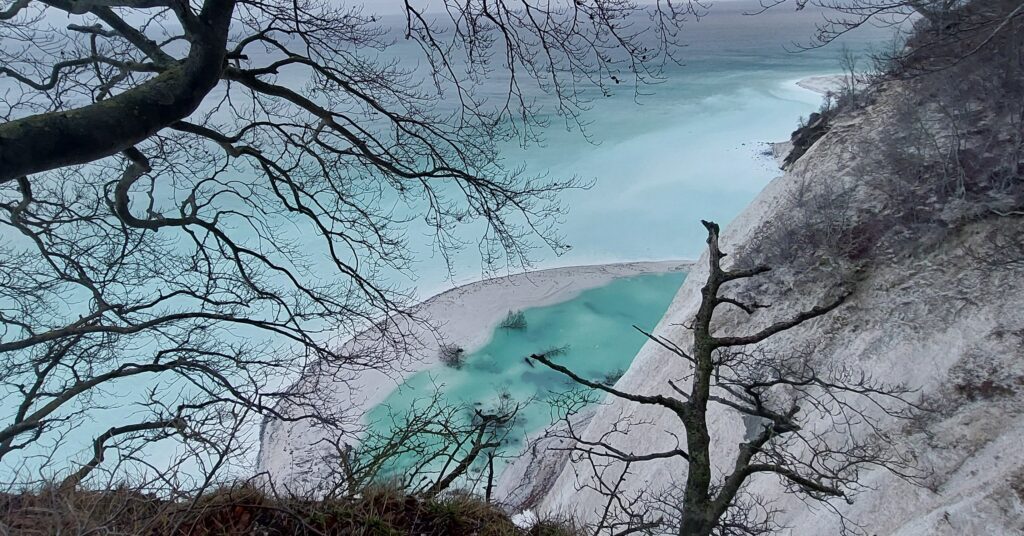
First in Denmark we did a short de-tour to the spectacular Møns Klint (don’t miss this if you’re passing, it’s stunning. You might (almost) think you’d just landed in the Caribbean😉). We then did a stop-over in Copenhagen to visit my lovely cousin Sarah living there, and to see the sights of this very cool city. Catching the onward ferry to Sweden (yes, we know we could have driven over the bridge to Malmo) we made a mental note that Denmark definitely deserves much more of our time… a return visit in summertime is on the cards.
Transit Sweden
Sweden is another ‘first’ for us and we have very little knowledge of the country (other than Abba and Ikea… of course). As we headed north from the ferry we passed not only an Ikea store, but an Ikea Museum! Okay… we are on a bit of a mission to get to the Arctic, but this has to be worth a quick stop. Love it or hate it, Ikea is an iconic and highly influential global brand that has revolutionised modern furniture in many countries. The back-story and brand ethos is quite an inspiring story.
Next stop was Stockholm. We’re not really ‘city people’, but having enjoyed Copenhagen a few days earlier, we had to give Stockholm a fair chance too. The city’s medieval history is interesting and we enjoyed the Royal Palace. But in my personal opinion, no self-respecting teenager of the 1970s can miss paying homage to the pop-gods at the Abba Museum.






Photo Gallery – Stockholm and a bit of south Swedish culture
Just north of Stockholm we stopped-off to visit our Swedish friend Johan from our days in Doha, Qatar. Not only was it great to catch up with him and meet his lovely family, but it was particularly useful for some tips on a route to our Nordkapp goal. The embryonic plan was slowly emerging…
En-route Plan
In terms of route, it seemed we could head a short distance up the east coast to Tönnebro, then cut across to the E45 northbound to the Arctic Circle and Nordkapp. But then I read about the Lofoten Islands in Norway… apparently a ‘must do’ of the region. How had we never heard of this place before???
Initially it looked like it would require a long detour west and northwards via Narvik. Then I read about the Norwegian coastal ferries. Ha! Well, whaddya know… it’s not such a long detour after all!! We can just hop across the mountains on the E12 from Sweden, cross the Arctic Circle line in Norway on the E6, then descend to Bodø for a ‘short-cut’ ferry to Moskenes/Lofoten. The beauty of winter travel is that nothing is busy or booked-up (probably because nobody else is stupid enough to come here at this time of year 🤣)
Plan-as-you-go Tolls
Our ‘plan-as-you-go’ tactic might sound all well and good in theory, but if we’re brutally honest, we should admit that it doesn’t always serve us well in practice. As we cruised through Belgium, I started looking into how we pay the (reportedly pricey) Norwegian road tolls. “No problem…” said the websites… “just apply for your Tag and you can get 20% discount on roads and ferries”. Sounds good, till you learn that said Tags have to be sent to your home address and should be ordered some weeks before you leave! The phrase ‘Bugger!’ springs to mind. If only we had planned ahead 🤣
Some Googling later, we realised that for our planned route, because we would be crossing into Norway fairly north, the discount available with a Tag wouldn’t save us much. The toll roads/bridges are mostly further south in Norway and there aren’t so many in the far north. It does seem however, to be worth registering on-line with Epass24.
From what we understand, the Epass24 organisation is charged by the Norwegian Government with collecting road tolls (generated by number-plate scanner as you drive under a gantry) from all foreign registered vehicles. If they have your details on their database, they can bill you promptly. If you don’t register your vehicle with them, they will take the lengthier process of contacting you via your home country registration department. This delay is likely to result in an additional fine by the Norwegian Government for late payment. We’ll let you know how it goes!
Tyres and Studs
Another thing we learned from our en-route research in social media, is how another British couple had really appreciated having snow-studded tyres on their Arctic trip. Cuthbert’s Michelin XZLs are ‘officially’ winter rated and totally legal for the snow/ice conditions. But we knew from our time in Canada that although they performed reasonably well at extremely low temperatures (below -20C when the rubber hardens), they weren’t as good as they could be at moderately cold temperatures (i.e. around 0C to -15C). We hadn’t bothered with studs in Canada and managed ok, but we decided this time to get some.
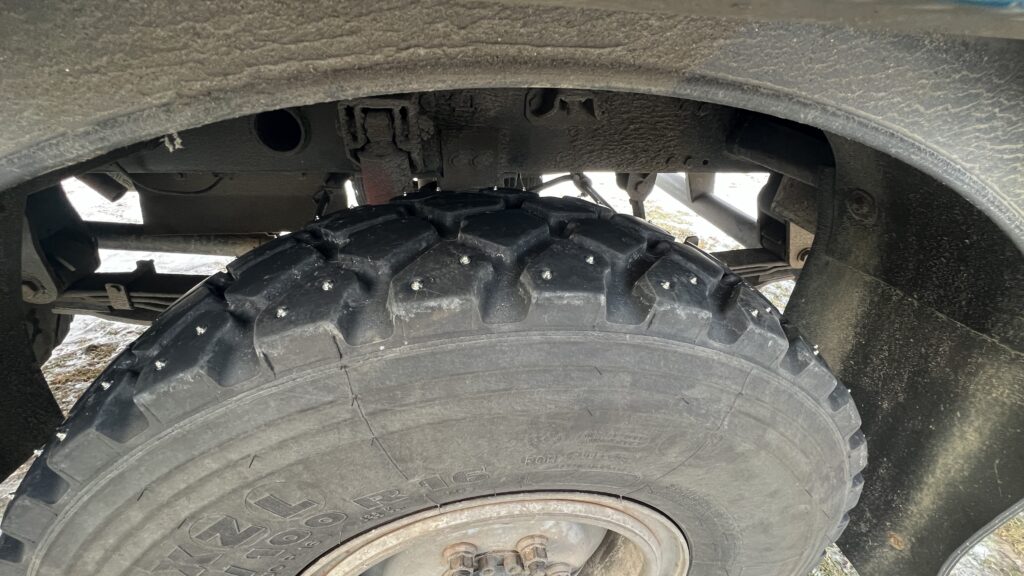
A bit of on-line research found a place in Eskiltuna (Best Grip) where we could buy them on our way through southern Sweden. A hefty 528 of the little suckers needed to be inserted individually into the tyre tread. Marcus had a fun morning rolling around in the Stockholm snow, doing this before we hit the ice-roads (see his video here). It was a bit of work, but we didn’t have to go much further north to realise it was a totally worthwhile exercise!
Alternate Alternator
Another little Cuthbert exercise that happened on the way north was the alternator giving up the ghost. To be fair, it had provided sterling service for 10 years (over 339,000 km) so it wasn’t unreasonable for it go (and we do, of course, carry a spare for just such occasions). But had it chosen to fail just 48 hrs earlier, then Marcus could have been changing it in a comfortably toasty +1/-1C outside. Instead, he had to spend 3 hrs under the truck at -20C wrestling with the fan belts to fit a new alternator. Ho hum.
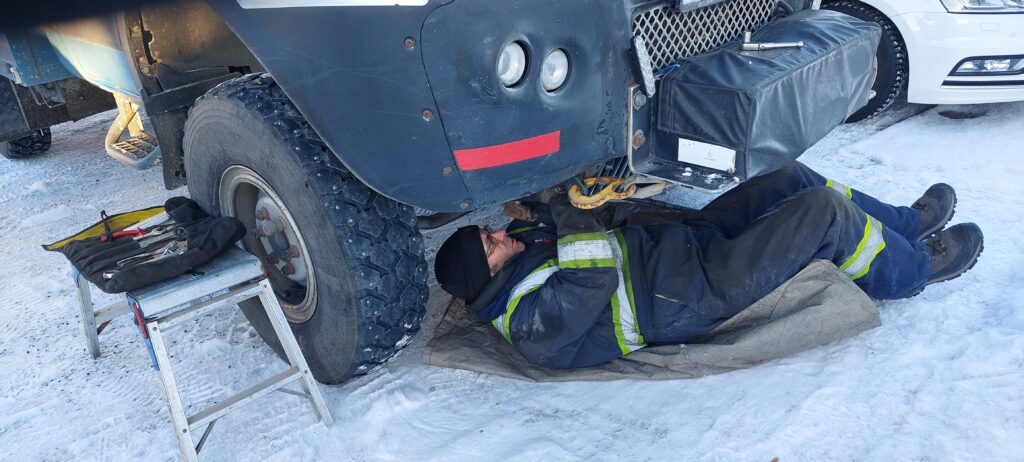
Cold Management
Alternator fixed, we moved north again. But of course it got even colder. Much colder. Temperatures gradually fell to a seriously low -33C and we started to remember the nitty-gritty of living in a camper-truck at these temperatures. Despite heating inside to +20C, thick ice forms around the door and window frames; handles and locks (the only real thermal bridges in Cuthbert’s construction) start to freeze solid. The engine takes a long time to pre-heat before driving (Cuthbert sports a very convenient little Webasto engine pre-heater) and the front cab gets very (very) cold overnight! In fact, when the outside temperatures don’t, even at midday, rise above -20C, the engine struggles to produce enough heat to heat the driving cab properly.
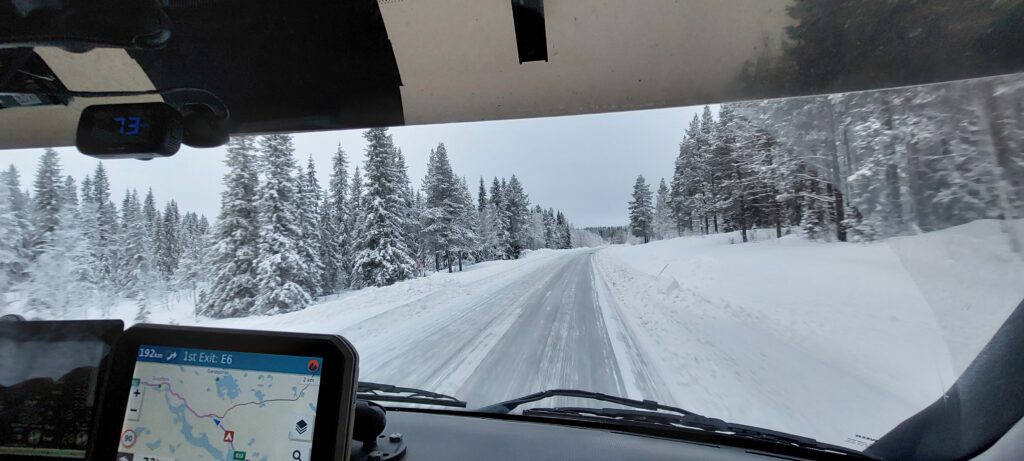
Arctic Again
Having (re)learned the lessons of the extreme cold, we were rather chuffed to finally arrive at the Artic Circle. There are signs for a café and a visitor centre, which we guess gets popular in summer. But right now, it’s all under snow. Only supply trucks (and the very occasional van-traveller as daft as us) plough up and down this road in the depths of February. We took the obligatory photo at the sign, just to compare with our pics of crossing the same line in a Yukon and Alaskan summer. A roadside truck stop seemed as good a place as any to spend the night before continuing to Bodø for the ferry to Lofoten.
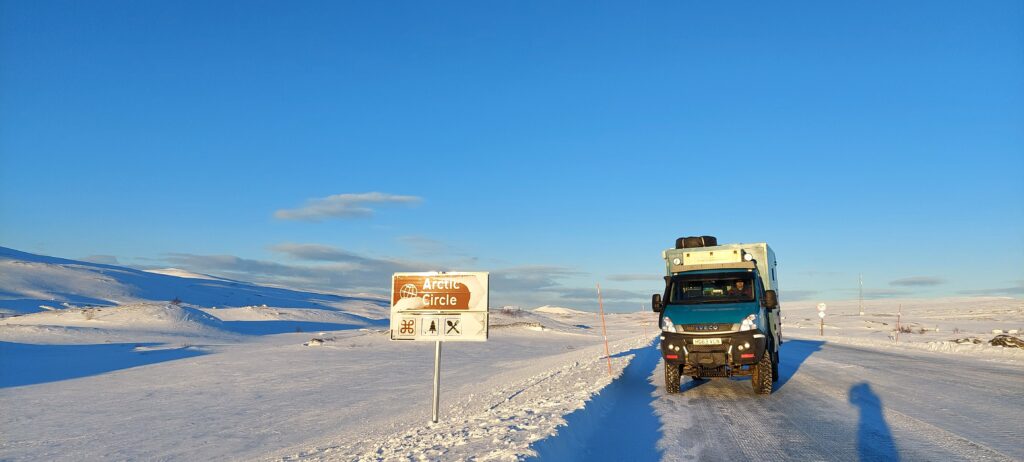
The descent from the mountains down to Bodø brought with it a welcome temperature increase. When the thermometer rose to -10C, the front cab heater started to work properly again – a luxurious novelty after the last few days of cold! And we arrived in Bodø to a truly tropical 0C!!! Wowser… it felt like we had landed in Barbados 🤣. This part of the Norwegian coast is apparently ‘warmed’ by the Gulf Stream, so the ocean never freezes and the air temperatures are relatively mild for the Arctic latitude.
A Few Firsts
On our way up to the Arctic Circle we had a few ‘firsts’ for our time in Europe: we saw our first moose, our first reindeer and our first Northern Lights! We saw these all in Canada, but fingers crossed we see many more of all of these in Europe!
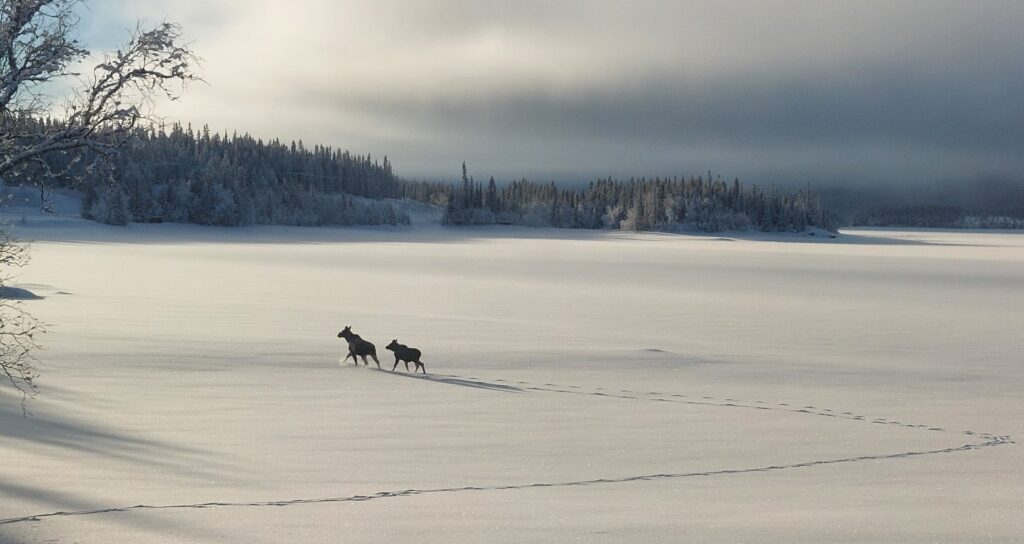
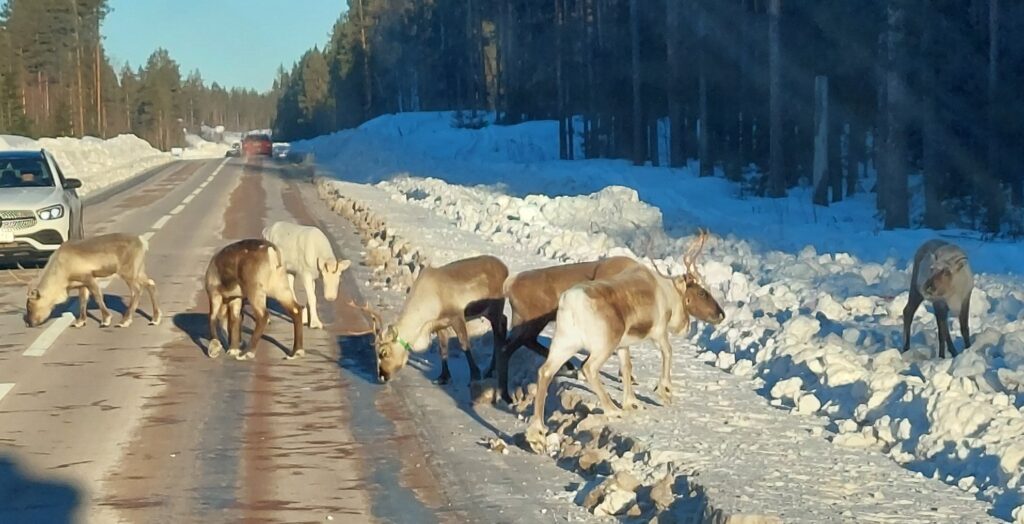
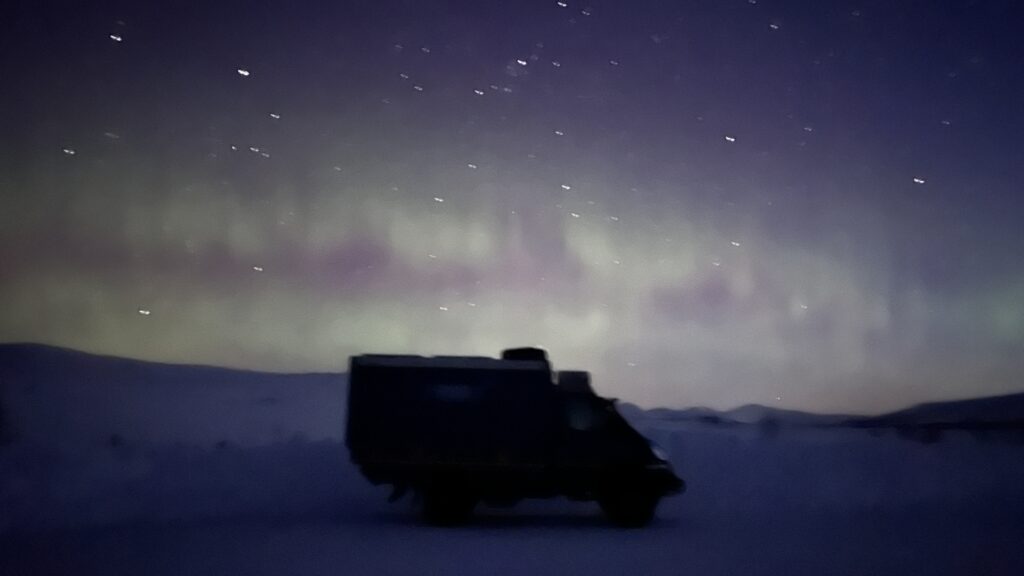
First moose, first reindeer, first Northern Lights
Ferry Far
A ‘ferry fact’ that we learned en-route is that in winter, the number of ferries doing the 3.5hr crossing from Bodo to Moskenes/Lofoten is greatly reduced, and they cross mostly at night. Given the beauty of the Norwegian coastline, it seemed a crime to miss all the views with a night-time sailing. In summer we guess the views are available around the clock, but in winter, we can highly recommend a teeny bit of planning to make sure you get a daylight crossing.
Arriving in Lofoten seems as good a place as any to sign-off for now. All being well, we’ll be heading north over the bridges between the islands, and will be able to bring you shortly, vistas of spectacular Norwegian coastal scenery draped in a white cloak of sparkling snow! Watch this space as we continue overlanding to the Arctic Circle and ‘Destination Nordcapp’.
